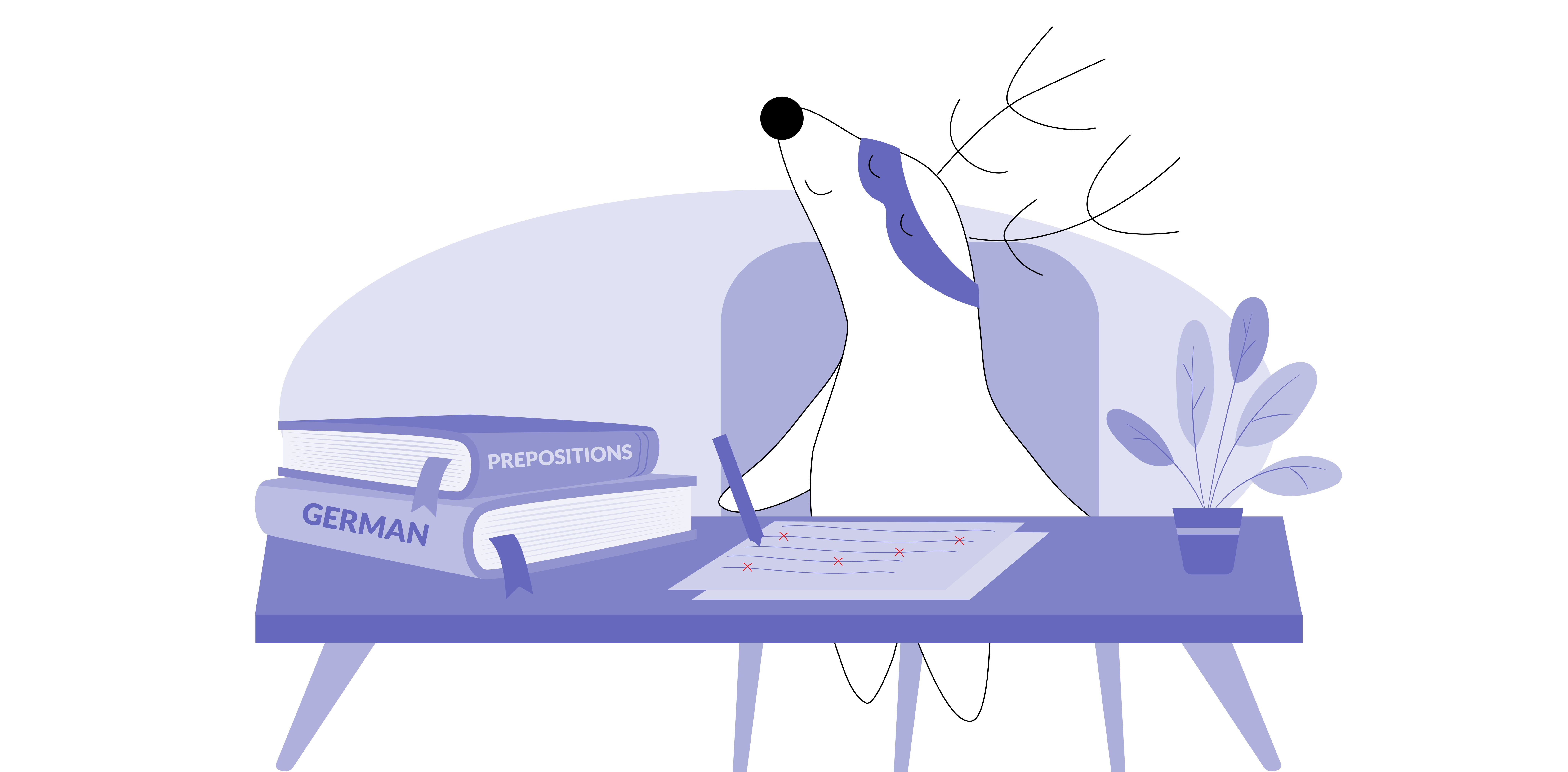
Prepositions are what hold sentences together — without them, we couldn’t give instructions or directions. In other words, it would be very difficult to talk about actions. We couldn’t say that we went to somewhere or put something on.
So, what about prepositions in German? Read on to discover the basics about German prepositions along with the most important ones to learn on your path to German comprehension!
Learn German with Langster
The Four Cases of German Prepositions
One of the things that makes German prepositions tricky is the German case system. While case only directly affects nouns and pronouns, understanding German prepositions will give you a good clue to which case to use. Let’s review:
- The German nominative case is used for the subject of the sentence — in other words, who or what is performing an action.
- The German accusative case is used for the direct object of a sentence — who or what is receiving the action.
- The German dative case is used for an indirect object — to whom or for whom the action is performed.
- Finally, the German genitive case shows possession, or the relationship of one noun/pronoun to another noun/pronoun.
Different prepositions denote different cases, so you’ll have to modify the following noun or pronoun accordingly. But, if this sounds overwhelming, don’t worry! Once you start learning, you’ll soon notice patterns in which prepositions are grouped together.

Differences from Prepositions in the English Language
First, let’s talk about some ways that German and English prepositions are used differently, as there are some nuances that may confuse new learners.
For example, to ask about a tv show we see our friend watching in English, we would say “What’s on the tv?” However, the direct translation for “on” in German is the preposition auf, and if you asked Was ist auf dem Fernsehen?, you would be understood as asking what is physically on top of the television. Instead, you want to use the preposition im. Later, we’ll talk about how this is a prepositional contraction of in and the article dem.
German
English
Was ist im Fernsehen?
What's on TV?
On the other hand, while in English, we would say that a book is in a particular language, in German, you would say it is on the language.
German
English
Das Buch ist auf Englisch
The book is in English
These are just a few examples of idiomatic differences that you’ll need to look out for when learning how to use German prepositions. So, pay attention to how words are used in context, and study how native German speakers phrase things in real life.

The Most Important German Prepositions
Now that we’ve covered some things to look out for when using German prepositions, let’s discover which ones are the most important to know as a beginner learning German!
In
This German preposition in is actually a cognate — a word that has the same meaning in multiple languages. In this case, it has the same meaning as the English preposition! With location, it is used specifically when the movement will take you inside your destination. Keep in mind that just because you don’t specify going inside in English, doesn’t mean you won’t do so in German.
German
English
Ich gehe ins Kino.
I go to the movies.
It is also an example of two-way German prepositions. That is, prepositions that can be used with either the accusative or dative case. Luckily, there’s a simple rule to when each particular case is used: if there is motion involved, use the accusative. If you are describing a static position, use the dative.
German
English
Der Hund lief in den Garten.
The dog ran into the garden.
Der Hund lief im Garten.
The dog ran in the garden.
In the first example, the dog is moving from one location into another. In the second, the dog is inside the garden the whole time.
Auf
Like in, auf is one of the two-way prepositions — you will use it with a different case depending on whether you are describing an object already sitting on top of a horizontal surface or one that is moving onto that surface. It is also similar to in because it takes on additional meanings when talking about location.
With locations, you will use auf if you will end up on top of something. It is also used when talking about going to a public space or event.
German
English
Ich klettere auf den Berg.
I climb the mountain.
An
An is the other half of auf, in a way (including being another two-way preposition). Rather than horizontal surfaces, it describes an object on a vertical surface. It is also used with motion and location to describe a precise spot.
Zu
Zu is one of the many ways to say “to” in German, and it is specifically used to say when you are going somewhere that you mention by a proper name, like McDonald’s. It is also used to say you’re going somewhere when it wouldn’t make sense to say you’re going inside.
Like auf, it can also be used to say you are going to an event or public space, and using zu is sometimes more common. One unique aspect of this preposition is that it can also be used with an adjective to mean “too,” as in too much of something.

Nach
Nach is a preposition that can take on two different meanings depending on the context. First, it can be used with the dative case to describe doing something after something else.
German
English
Nach dem Unterricht treffen wir.
We meet after class.
However, its other use is as a form of to when talking about direction and motion. You will use nach when talking about most locations with proper nouns, such as countries, cities, and states. The exception to this is locations that have “the” in their title — for those, you will use in.
German
English
Ich reise nach Deutschland.
I am traveling to Germany.
You will also use nach with general directions.
German
English
Nach links.
To the left,
Remember that nach is one of the German dative prepositions, so seeing it means that there will be an indirect object somewhere in the rest of the sentence that the action is being performed on.
Bei
Bei is a German preposition that we would call a false cognate — while it sounds like the English preposition “by,” it actually has an entirely different meaning! We would use this preposition to say where something is or what it is near.
This preposition can also be used to specifically say “at the house of,” in which case it would be more common to translate it as “with.”
German
English
Ich wohne bei meinem Freund.
I live with my boyfriend.
This preposition is used with the dative case.
Wegen
Wegen uses the genitive case; however, the genitive form is falling out of use in modern German. While it’s still important to know and use this form in formal writing, such as writing an essay or reading an old text, in casual conversation it is common to just use the dative case instead.
Another important thing for learners to remember is that wegen cannot be used the same way as weil.
German
English
Weil
because
Weil is a conjunction that connects two independent clauses — one giving a statement and the other explaining a reason or cause for that statement. Wegen is simply followed by a noun or pronoun. This may sound confusing, but in practice it can be compared to using active versus passive voice. Consider these two examples:
German
English
Ich habe wegen meiner Krankheit den Unterricht verpasst.
I missed class because of my illness.
Ich habe den Unterricht verpasst, weil ich krank war.
I missed class because I was sick.
See how “I was ill” can be a sentence all on its own if we remove “because,” but “my illness” is just a noun following “because of”? That’s all there is to it!
Für
This one is a straightforward accusative preposition — the English equivalent of “for.” Remember that as an accusative, this preposition denotes that the subject of the sentence is acting on a direct object.
Mit/Ohne
While you might be tempted as a beginner to translate “without” directly as something like mit kein, this is actually incorrect. Instead, we’ll use the separate word ohne.
Likewise, since they seem like the positive and negative version of the same expression, you might assume that they are the same prepositional case. However, mit is dative, while ohne is accusative.
German
English
Ein Huhn ohne Kopf.
A chicken with no head.
German Prepositional Contractions
Finally, you can’t learn German prepositions without being able to identify them — and they might not always look the same. Sometimes, prepositions will appear as prepositional contractions, meaning that they are combined with a definite article. This is similar to how in the English language, phrases like “I am” and “you will” are often shortened to “I’m” and “you’ll.”
Let’s take a look at some common contractions.
German
English
Ans
an + das
Am
an + dem
Aufs
auf + das
Beim
bei + dem
Fürs
für + das
Ins
in + das
Im
in + dem
Zum
zu + dem
Zur
zu + der
The Bottom Line

Prepositions are a tricky aspect of the German language to master, but breaking them down and focusing on the most important ones first can help you learn. With this short list, you’ll be able to communicate most basic directions, thoughts, and instructions, or at least give your German companions an idea of what you’re trying to say. There are many other prepositions out there that you’ll learn in time.
Remember that the best way to learn the different, nuanced contexts of German prepositions is to use them in real-life situations, like talking with German friends or reading German texts. So, download the Langster app today to get started with your first free German story! With Langster, you’ll be able to read texts that suit your learning level, and can even use the flash card feature to further practice this new vocabulary.








